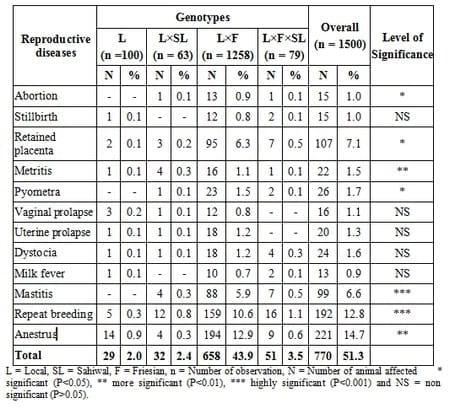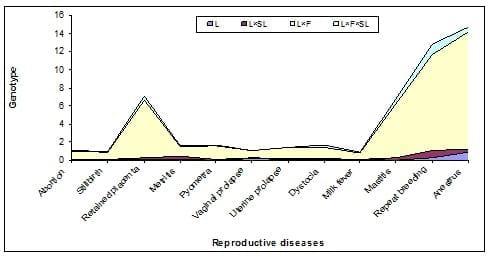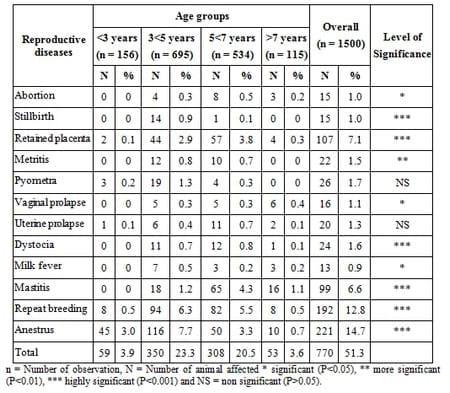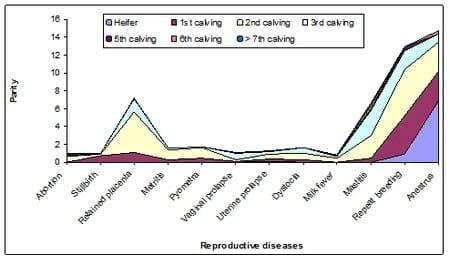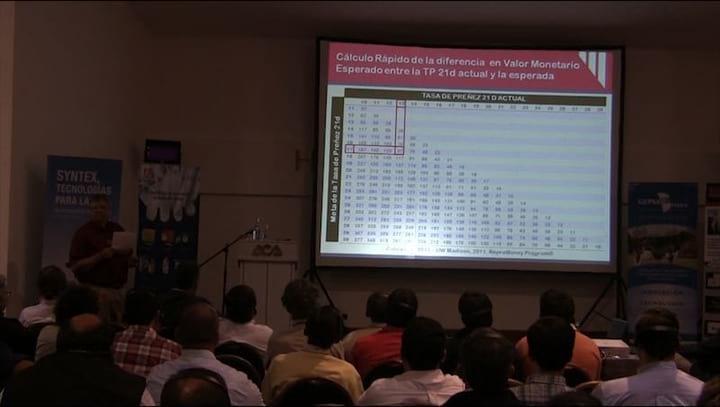Abstracts
Reproductive disorder among farm animals is the great economic problems. To determine the reproductive problems of dairy cattle at Bogra district in Bangladesh were grouped on the basis of genotype, age and parity. A total 1500 data were collected by using individual questionnaire model, compiled SPSS package to obtain result and student t-test for interpretation. Genotype had significant (P< 0.05) effect on abortion, retained placenta, metritis, pyometra, mastitis, repeat breeding, anestrus. The genotype L×F was showed 0.9%, 0.8%, 6.3%, 1.1%,1.5%, 0.8%, 1.2%, 1.2%, 0.7%, 5.9, 10.6% and 12.9% highest prevalence on abortion, stillbirth, retained fetal membrane, metritis, pyometra, vaginal prolapse, uterine prolapse, dystocia, milk fever, mastitis, repeat breeding and anestrus, respectively. Age group had significant effect (P< 0.05) on abortion, retained placenta, metritis, mastitis, repeat breeding, anestrus, stillbirth, vaginal prolapse, dystocia, milk fever Age group had significant effect (P< 0.05) on abortion, retained placenta, metritis, mastitis, repeat breeding, anestrus, stillbirth, vaginal prolapse, dystocia, milk fever and the age group of 5 to <7 years showed the highest prevalence in abortion (0.5%), retained placenta (3.8%), uterine prolapse (0.7%), dystocia (0.8%) and mastitis (4.3%) and age group of 3 to <5 years showed the highest of stillbirth (0.9%), metritis (0.8%), pyometra (1.3%), milk fever (0.5%), repeat breeding (6.3%) and anestrus (7.7%). The highest prevalence of abortion was (0.6%) in 2nd calving, stillbirth (0.7%) 1st calving, retained placenta (4.5%), metritis (1.1%), pyometra (1.1%), uterine prolapse (0.5%), dystocia (0.7%), milk fever (0.5%) and repeat breeding (5.2%) in 2nd parity, vaginal prolapse (0.7%) and mastitis (2.8%) in 3rd parity and anestrus (6.9%) in haifer.
Key word: Prevalence, Reproductive disorders, Genotype, Age and Parity.
Introduction
Bangladesh is a densely populated agricultural country. The country consists of low, flat, and fertile land except the hilly regions in northeast and southeast. The mean annual temperature is about 260C with an extreme range between about 40C and 430C. The average annual rainfall varies from 1429 to 4338 mm. Cattle among other livestock species available are the most versatile component in relation to existing integrated agricultural farming system in Bangladesh. Total cattle population of this country is about 24.5 million, which is about 1.79% of the world and 5.47% of Asia cattle population (FAO, 2004). In the last 10 years, the cattle population has increased by 0.3% in contrast with 0.4% of the world. Number of cattle per livestock household is 3.5 and that of 0.94 for all household (BBS, 2002).Reproductive disorder among farm animals is the great economic problems. It is particularly widespread among dairy cattle, but it is of lesser significance in the beef breeds (Arthur et al., 1988). One of the major constraints of profitable dairy farming is low conception rate (Alam and Ghosh, 1994; Shamsuddin et al., 2001). Economy of dairy farming largely depends on pregnancy rate after insemination. The twelve-month calving interval is advantageous for maximal milk yield per cow per year with good economic return (Opsomer et al., 1996). It is accepted that bovine genital infections, either specific or non-specific in nature, account for large number of pregnancy failure in cows (Sirohi et al., 1989). Shamsuddin et al. (1988) studied the relative percentages of retained placenta, metritis, pyometra, endometritis, cervicitis, persistent corpora lutea, cystic ovaries and non functional ovaries were 42.26%, 10.38%, 8.15%, 27.39%, 1.52%, 1.17%, 3.13%, and 5.95%, respectively. So, the study was designed to investigate the magnitude of major reproductive disorders in indigenous and cross bred cattle in Bangladesh. Although, major reproductive disorders greatly responsible for high economic loss in dairy cows, the research was done on the prevalence and economic impact of the reproductive disease in Bangladesh.
Materials and Methods
This study was conducted out to determine the prevalence of reproductive diseases in 1500 dairy cows belongs to L (Local, n = 100), L × SL (Sahiwal; n = 63), L× F (Friesian; n = 1258) and L × F × SL (n = 79) from 4 Upazila at Bogra district during the period from July 2010 to June 2011. Records of clinical cases and the data were collected directly from the dairy cow´s owners by using questionnaires. Diagnosis of reproductive diseases was made on the basis of the history, clinical signs and response to treatment. The data were entered and managed in SPSS program. Descriptive statistics was done to explore the prevalence of reproductive diseases and Duncan t- test was to determine the level of significance among clinical cases of cows of different private dairy farms at Bogra district.
Results
The percentage prevalence of reproductive diseases viz., abortion (1.0%), stillbirth (1.1%), retained placenta (7.1%), metritis (1.5%), pyometra (1.7%), vaginal prolapse (1.1%), uterine prolapse (1.3%), dystocia (1.6%), milk fever (0.9%), mastitis (6.6%), repeat breeding (12.8%) and anestrus (14.7%) in relation to genotype, age and parity of cows. Anestrous syndrome is the most important causes of infertility of cows in Bangladesh. In present study, 14.7% anstrus syndrome was recoded. Sarder et al. (2010) reported very high incidence of anstrus (20.4%). Among reproductive diseases, in the present study, repeat breeding was the second highest common reproductive diseases which were 12.8%. Similarly, introduction of artificial insemination for cattle development program may contribute on this high occurrence. Anestrus and repeat breeding had the highest incidence and this result is similar to many authors. Serur et al. (1982) reported the higher prevalence of anestrus and repeat breeding (49.9% and 15.1%, respectively) in cows which is littlebit higher than the present study. Rahman et al. (1983) also reported very high incidence of anestrus. The lower prevalence of anestrus and repeat breeding may be due to difference in the number of sample size, farm management, breeds of cattle by suppressing oestrus and ovulation, causing anestrus, anovulation and early embryonic death. Jainuddin and Hafez (1993) also reported that incidence of repeat breeder is higher at artificial insemination rather than natural service. Poor quality semen, defective transportation of semen, unhygienic insemination among other is the main cause of repeat breeding syndrome in our country. Error in estrus detection and improper timing of AI further aggravates the situation (O´ Farrel et al., 1983, and Kumaresan, 2001). Genotype had significant (P< 0.05) effect on abortion, retained placenta, metritis, pyometra, mastitis, repeat breeding, anestrus and had no significant (P>0.05) effect on stillbirth, vaginal prolapse, uterine prolapse, dystocia and milk fever. The highest prevalence of abortion, stillbirth, retained fetal membrane, metritis, pyometra, vaginal prolapse, uterine prolapse, dystocia, milk fever, mastitis, repeat breeding and anestrus were 0.9%, 0.8%, 6.3%, 1.1%,1.5%, 0.8%, 1.2%, 1.2%, 0.7%, 5.9, 10.6% and 12.9% in L×F genotype. This findings are little bit differ from Sarder (2008) which may be due to breed variation, age, body weight, condition etc.
Table 1. The effects of genotypes on the prevalence of reproductive diseases of dairy cows.
Fig. 1. The effects of genotypes on the prevalence of reproductive diseases of dairy cows.
Age group had significant effect (P< 0.05) on abortion, retained placenta, metritis, mastitis, repeat breeding, anestrus, stillbirth, vaginal prolapse, dystocia, milk fever Age group had significant effect (P< 0.05) on abortion, retained placenta, metritis, mastitis, repeat breeding, anestrus, stillbirth, vaginal prolapse, dystocia, milk fever and had insignificant effect on pyometra and uterine prolapsed. The age group of 5 to <7 years group showed the highest of abortion (0.5%), retained placenta (3.8%), uterine prolapse (0.7%), dystocia (0.8%) and mastitis (4.3%) and age group of 3 to <5 years showed the highest of stillbirth (0.9%), metritis (0.8%), pyometra (1.3%), milk fever (0.5%), repeat breeding (6.3%) and anestrus (7.7%). All the reproductive diseases were the lowest in <3 years aged group cows except pyometra and anestrus which were the highest in >7 years age group cows. Sarder (2008) reported the higher the incidence of abortion, metritis, cystic ovary, vaginal prolapse, uterine prolapse, retained placenta, dystocia, anestrus and repeat breeding were higher in >8 years old cows and lower in <4 and 4-6 years old cows. The variation of results might be due to age group, breed, body weight, body condition, managemental factors, environmental factors etc.
Table 2. The effects of age groups on the prevalence of reproductive diseases of dairy cows.
Fig. 2. The influences of age groups on the prevalence of reproductive diseases of dairy cows.
Table 3. The effects of parity on the prevalence of reproductive diseases of dairy cows
Fig. 3. The effects of parity on the prevalence of reproductive diseases of dairy cows.
The prevalence of abortion was the highest (0.6%) in 2nd calving and the lowest (0.0%) in heifer, 1st calving, 6th calving and > 7th calving. The prevalence of stillbirth the highest (0.7%) 1st calving and the lowest (0.0%) in heifer, 5th calving, 6th calving and > 7th calving. Similarly retained placenta (4.5%), metritis (1.1%), pyometra (1.1%), uterine prolapse (0.5%), dystocia (0.7%), milk fever (0.5%) and repeat breeding (5.2%) were higher incidence in 2nd parity, vaginal prolapse (0.7%) and mastitis (2.8%) was the highest in 3rd parity and anestrus (6.9%) in haifer. Present study showed the most of the RD in 2nd parity which is similar with the findings of Bicalho et al. (2007).
References
Alam MGS and Ghosh A. 1994. Reproductive performance in cows: it´s relationship to parity and season. Bangladesh Veterinary Journal.22: 51-61.
Arthur GH, Noaks DE, Pearson H and Parkinson TJ. 1988. Veterinary Reproduction and Obstetrics. 7th Edn. W.B. Saunders Company Limited, London, Philadephia, Toronto, Sydney, Tokoyo, pp:345-388.
BBS (Bangladesh Bureau of Statistics). 2002. Statistics year book of Bangladesh. Ministry of Planning, Dhaka. Bangladesh.
Bicalho RC, Galvao KN, Cheong SH, Gilbert RO, Warnick LD and Guard CL. 2007. Effect of stillbirths on dam survival and reproduction performance in Holstein dairy cows. Journal of Dairy Science. 90 (6): 2797-2803.
FAO. 2004. Food and Agriculture Organization of the United Nations. Ministry of Fisheries and Livestock, Bangladesh. pp: 65.
Jainuddin MR and Hafez ESE. 1993. Reproductive Failure in Female. In: Reproduction in Farm Animals. 6th edn. Lea & Febiger Philadelphia, USA. pp. 261-286.
Kumaresan A. 2001. Repeat breeding syndrome in cattle and buffaloes; therapeutic approach at field level. Pashudhan. 16: 4.
O´Farrel KJ, Langley OH, Hartigan PJ and Sreenan JM. 1983. Fertilization and embryonic survival rates in dairy cows culled as repeat breeders. Veterinary Record.112: 95.
Opsomer G, Mijtem P, Coryn M and Kruif AD. 1996. Postpartum anestrus in dairy cows, a review. Veterinary Quarterly 18 (2): 68-75.
Rahman MM, Chowdhury TIMF, Rahman A and Haque F. 1983. Seroprevalence of human and animal brucellosis in Bangladesh. Indian Veterinary Journal. 60: 165-168.
Sarder MJU, Moni MIZ and Aktar S. 2010. Prevalence of reproductive disorders of cross breed cows in the Rajshahi district of Bangladesh. SARC journal of Agriculture.8 (2): 65-75.
Sarder MJU. 2008. Occurrence of reproductive disorders in crossbreed cows of Northern Bangladesh. 15th International Congress on Biotechnology in animal Reproduction. 74.
Serur BH, Farrag AA, Gomaa A. 1982. Incidence of certain infertility problems among cows and buffaloes in Upper Egypt. Assiut Veterinary Medical Journal. 10:209-214.
Shamsuddin M, Alam MGS and Ahmed JU. 1988. Reproductive disorders of cross-bred cows. Bangladesh Veterinary Journal. 22 (24): 21-28.
Shamsuddin M, Alam MGS and Ahmed JU. 1988. Reproductive disorders of cross-bred cows. Bangladesh Veterinary Journal. 22 (24): 21-28.
Shamsuddin M, Bhuityan MMU, Sikder TK, Sugulle AH, Chanda PK, Alam MGS and Galloway D. 2001. Constraints Limiting the Efficiency of Artificial Insemination of Cattle in Bangladesh International Atomic Energy Agency, Vienna, Austria.
Sirohi NS, Monga DP and Knar SK. 1989. Microbiological studies on some reproductive disorders of cattle. Indian Journal of Animal Sciences. 59 (5): 537-541.
Sirohi NS, Monga DP and Knar SK. 1989. Microbiological studies on some reproductive disorders of cattle. Indian Journal of Animal Sciences. 59 (5): 537-541.
